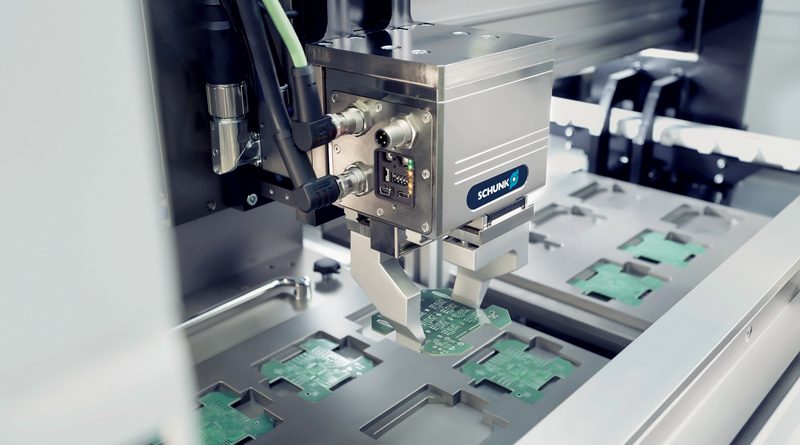Ready for an Increasingly Mechatronic Industry
The growing focus on mechatronics, the brand new collaborative grippers and their safety-related issues, the role of Italy in the company’s global strategy. At Automatica, we had the opportunity to meet Harald Dickertmann, Chief Sales Officer at SCHUNK, and talk with him about some of the hottest topics in advanced handling and gripping.
by Fabrizio Dalle Nogare
SCHUNK is strengthening its position as a leading actor in handling and gripping applications. What can you say about the current situation of the company?
SCHUNK was founded more than 70 years ago and has been working for over 35 years in the field of gripping systems, where we have the broadest portfolio of solutions. Today, SCHUNK employs about 3,400 people worldwide and its turnover has more than doubled within the last 10 years. This means we have been experiencing a steady growth and we expect very good results – a double-digit growth on a worldwide base – also in 2018. We are growing in all the countries where we have branches or offices. Generally speaking, as SCHUNK we expect some more big advancements in the next 2 to 4 years and we are working hard to be prepared for this.
So far, electrically driven components are becoming more and more widespread in handling and assembly applications. How is the market welcoming these solutions? Is SCHUNK driving its R&D activities mainly towards this technology?
Lately, we have had quite a strong focus on the development of mechatronic or electrical gripping systems. In fact, despite the pneumatic technology is still very well known and largely employed, also our customers are requesting more and more air-free solutions. For this reason, we added three mechatronic lines to our portfolio: the first is made of products which are easy to convert from pneumatic to mechatronic technology. Then, we have highly flexible products that can fit with electrical actuation or servo motors from several manufacturers. Finally, our 24V series goes even further: we do not provide only the gripper but rather a whole system in which the grippers perfectly fit. To sum up, that’s where the market is going. Of course, now we sell above all pneumatic grippers, but we see really high growth rates as for mechatronic components.
SCHUNK’s collaborative grippers, awarded last year at Hannover Messe, are still a hot issue. Does it mean that you really believe in the development of collaborative robotics?
Personally, I do believe in the coexistence between traditional industrial robots and cobots, which imply one big advantage. They make it possible to open new markets also because they are quite different compared to traditional industrial robots, employed especially in serial production, where low cycle times and very high productivity rates are required. Cobots, for example, allow either big industry players or SMEs to automate assembly tasks that have always been carried out manually or rather to actively support operators in their work. In addition, we’ll need more and more flexibility in the future, meaning smaller batches and quicker re-tooling.
Safety is a primary issue when it comes to advanced gripping systems like the collaborative ones. How is SCHUNK facing such a crucial aspect?
Especially in Europe, the focus is of course on safety and our Co-act gripper EGP-C is safety-certified. What I see when I visit the factories around the world is that many cobots and collaborative installations are equipped with standard grippers. The capacitive sensing technology that we integrate in our grippers makes the end-effector stop before touching the operator. I believe that a truly safe collaborative application should not stop when touching the operator, but rather before, so to make the cooperation between robots and human workers easier. In addition, some large companies, like the ones working in the automotive industry, might not take the risk of a possible contact between the robot and the operator.
How do you consider the Italian market and industry? Is it still a primary one in the global scenario?
After the crisis, the Italian market has never been as strong as today. It’s a very important time for the whole country, including industry. The government’s tax incentives helped boosting the domestic market and, on the other side, export is quite strong. A lot of Italian companies, either integrators or machine builders, are very oriented to Asia, and we know that the Asian market is a primary one, especially for automation.
We established our branch in Italy about 20 years ago and Mr Andreas Kuehl, since the beginning in charge of the Italian branch, has done an incredible job so far and we are very happy with our position in the Italian market.
What is the role of the assembly sector for SCHUNK in Italy?
The assembly sector is certainly a primary one. The strength of machine builders and integrators in Italy is their high creativity and flexibility: all features that fit perfectly to our high-quality standard products. Also, these products and machines are sold around the world and it’s important for us that we are basically everywhere with our own subsidiaries. Besides, as shown here at Automatica, our products are open for any robot manufacturer or system. Having a very broad portfolio and partnership opportunities is absolutely crucial nowadays.

